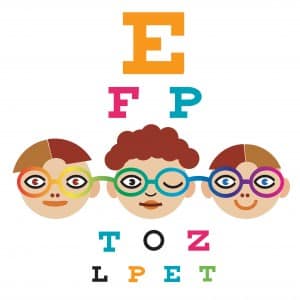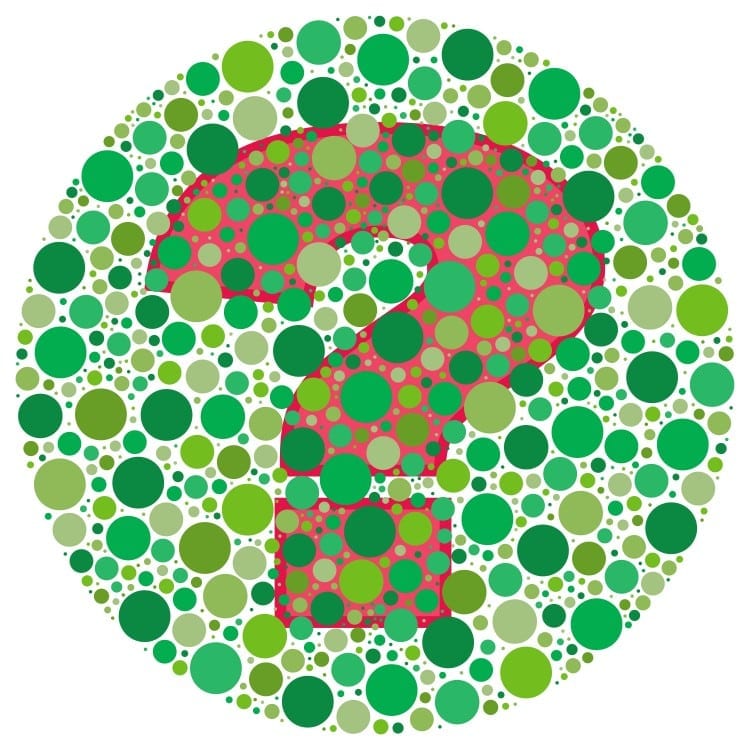Color-blindness or Color Vision Deficiency, as the experts call it, is the inability to distinguish shades of color or in more severe cases, to see any colors at all. Most of us think of color-blindness as an interesting difference, like having blond hair or brown hair. But it’s really not that simple. Being color-blind in a color-coded world causes all sorts of difficulties that most of us never think about.
For instance, you’re cooking a steak, and you have red/green blindness. There’s simply no way to know when your steak is well-done, the way you like it.
Or say your child is playing a handheld game and it’s time to charge the battery, only your child doesn’t know it because he doesn’t see the difference in color when the LED display changes from green to red.

In the educational system, color-blindness can become a serious liability for a child. Many of the materials used in the classroom make use of color as an educational tool. As an example, Mary may be given a reading worksheet with words on one side and pictures on the other side of the page. The girl is told to draw lines from the words to the pictures. The words are (did you see this coming?) red, yellow, and green. The pictures are of traffic lights, each with a different color lit up. Mary is supposed to draw a line from the word “red” to the traffic light that is red, but she can’t tell the difference between red and green so she takes a wild stab and gets it wrong.
The teacher cautions Mary not to be so careless. But things like this keep happening in class. The teacher sends a note home, requesting a parent-teacher conference. Mary is suspected of having a learning disability, the parents are told. But in actual fact, the little girl has no learning disability at all. She just can’t see the difference between red and green, only no one has figured that out: not her parents, and not her teachers. Probably not even Mary herself.
Wait a second, you might be thinking: if color-blindness affects Mary’s ability to learn, why is it not considered a learning disability? As often happens with the educational system, it’s about legislation. The definition of a learning disability, according to the U.S. Individuals with Disabilities Education Act (IDEA) is this:
A disorder in one or more of the basic psychological processes involved in understanding or in using language, spoken or written, that may manifest itself in an imperfect ability to listen, think, speak, read, write, spell, or do mathematical calculations, including conditions such as perceptual disabilities, brain injury, minimal brain dysfunction, dyslexia, and developmental aphasia.
Meantime, show Mary a picture book of colors designed to teach her how to read color names. The only problem is that “red” and “green” appear to be names for the same color. So Mary dutifully memorizes the spelling of both and tries to guess which spelling to use at any given time. She’s floundering.
What she needs is specialized classroom materials that don’t require color to get the lessons across. Happily for Mary, a vision examination at last exposed the reason for Mary’s difficulties. Everyone gave a big sigh of relief. This was something relatively simple, something manageable.
Mary’s teacher had never taught a student with color-blindness before. But she found a variety of ways to help Mary in the classroom. Here are some of the tricks she used to support Mary’s learning experience:
- Where color recognition was required, pictures were labeled with symbols or words
- Colored writing materials, for instance pencils, crayons, and pens, were labeled with color names and I make sure to get custom pens with the most intense colors
- White chalk on a blackboard was used in order to maximize contrast (as opposed to colored chalk on a green chalkboard).
- Schoolbooks printed with colored ink were xeroxed in black and white (Mary’s teacher learned that black ink on red or green paper was also a problem for Mary, who only saw a solid black page)
- A classmate was assigned to help Mary with assignments requiring color recognition such as coloring in the countries on a map during geography class
- Worksheets were created to help Mary learn the colors of common objects. Mary could then practice correctly choosing labeled markers to draw pictures of these items (for instance skies are blue and grass is green), cementing for her the association between items and their colors
- Finally, Mary’s teacher devoted some time to teaching her students about colorblindness. Once Mary’s peers understood her vision deficiency, and the teacher employed special classroom tactics to address the issue, Mary’s grades shot up to the top of the class. Not to mention the matter of Mary’s self esteem. The girl’s sense of self had suffered a stunning blow due to her early classroom difficulties and confusion. Now it came roaring back.

Kids can be tested for colorblindness
Color-Blindness: It’s Hereditary
Since color-blindness is a hereditary condition, Mary’s parents had her brother Joe tested for color vision deficiency before he started school. Sure enough, Joe was also color-blind, which is really no surprise, since boys are more prone to the condition than girls. Joe was lucky enough to receive help in the classroom right from the very first day of school.
Which is as it should be.
The moral of the story? Have your child tested for color-blindness before first grade.
Is your child struggling in class? Could it be color-blindness?

It’s a well written article. It reminds me one of my student, Warren, when I was a teacher at a school for learning disabilities
He was typically a happy reader, but later he does not volunteer to read. His problem stems from the fact that the story was printed in blue with a purple background.Warren was unable to see the letters clearly and therefore his confidence becomes shaky.read with confidence. At that time I was not educated in the area of colorblindness and misdiagnosed the problem. My fellow teacher helped me up to identify the real issue with my student by allowing Warren to read off of black and white copies of the story. It helped him to read with confidence.
Subway maps, charts/graphs, document edits in red, magazines with color overlays on text, traffic lights, matching cloths… You learn to cope, but there are obstacles that could be removed if there was a stronger recognition of the condition.
I hear you. I think people think of colorblindness as being about coordinating one’s clothes. It’s so much more than that. It’s sad that people have to suffer because of this lack of awareness.